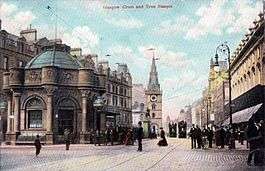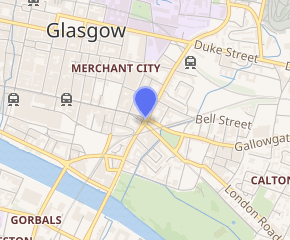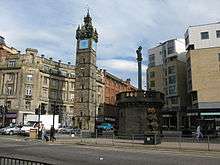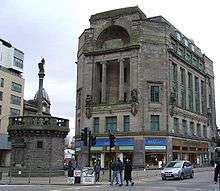Glasgow Cross
Glasgow Cross is at the hub of the ancient royal burgh and now city of Glasgow, Scotland, close to its first crossing over the River Clyde.[1] As a major junction in the city centre, its five streets run: north up the High Street to Glasgow Cathedral, Cathedral Square and the Royal Infirmary; east along Gallowgate and London Road, close to St Andrew's Square; south on the Saltmarket to Glasgow Green and the High Court;[2] and its own Trongate continuing west as Argyle Street towards St Enoch Square and Buchanan Street.
| Glasgow Cross | |
|---|---|
 Glasgow Cross looking west along Trongate in the 1900s | |

| |
| Location | |
| Glasgow | |
| Coordinates | 55.85659°N 4.24379°W |
| Roads at junction | High Street Gallowgate London Road Saltmarket Trongate |
| Construction | |
| Type | Signal-controlled intersection |
Its most recognisable features are the Tolbooth Steeple, part of the 17th century tolbooth, and the mercat cross replica commissioned in 1929 by William George Black, and designed by architect Edith Hughes.[3][4] In its civic and commercial make-up, many of the surrounding wholesale and manufacturing warehouses now operate as creative venues, galleries and art studios.
Linked to the Tolbooth stood the Tontine Hotel and its Assembly Rooms, designed from 1737 by architect Allan Dreghorn[5] with adaptations in 1781 by architect William Hamilton of St Andrew`s Square. The Tontine was the exchange centre of early mercantile business and the focal point of political and social gatherings. A number of artist paintings over the centuries depict Glasgow Cross, the Tolbooth and Tontine.[6][7] In front of the Tontine was placed the equestrian statue of King William III, erected in 1734; now sited at Cathedral Square.[8][9]
Glasgow Cross, in front of the Tontine, was the starting point of the regular passenger and mail coaches to Edinburgh and to London.
Tolbooth Steeple
Standing at the foot of High Street is the Tolbooth Steeple, built in 1626 at what was the meeting point of the main streets of Glasgow at that time. The Steeple is all that remains of the original Tolbooth buildings[10] which contained the town hall, court and jail. The Tolbooth housed the Glasgow Council Chambers until 1814, when the council sold the Tolbooth building (later demolished in 1921) and moved to Jail Square in the Saltmarket, before eventually moving to the current City Chambers in George Square. The 126-foot-tall (38-metre) steeple, complete with clock mechanism, was repaired in 2008 after cracks were discovered in the structure, along with masonry, lead and guttering improvements. Along with the nearby Tron Theatre, formerly the Tron Kirk built in 1794,[11] the Tolbooth Steeple is one of the oldest buildings in the city.

.jpg)

The presently disused Glasgow Cross railway station sits beneath the junction.
References
- Glasgow’s Crosses, Glasgow History, 28 May 2016
- https://www.scotcourts.gov.uk/the-courts/court-locations/glasgow-high-court
- "Glasgow - Mercat Cross". The Scotland Guide. Retrieved 20 April 2012.
- McKenzie, Raymond; Nisbet, Gary (2001). Public sculpture of Glasgow. Liverpool University Press. p. 340. ISBN 978-0-85323-937-6.
- http://www.glasgowsculpture.com/pg_biography.php?sub=dreghorn_a
- https://www.theglasgowstory.com/image/?inum=TGSA01062&t=2
- https://www.theglasgowstory.com/image/?inum=TGSE00522&t=2
- Glasgow, by Irene Maver, published in 2000
- Second City of Empire, by Charles Oakley, published in 1975
- http://www.scottisharchitects.org.uk/building_full.php?id=221984
- http://www.scottisharchitects.org.uk/building_full.php?id=226283
External links
- Glasgow History[1]

- Glasgow Cross at The Scotland Guide
